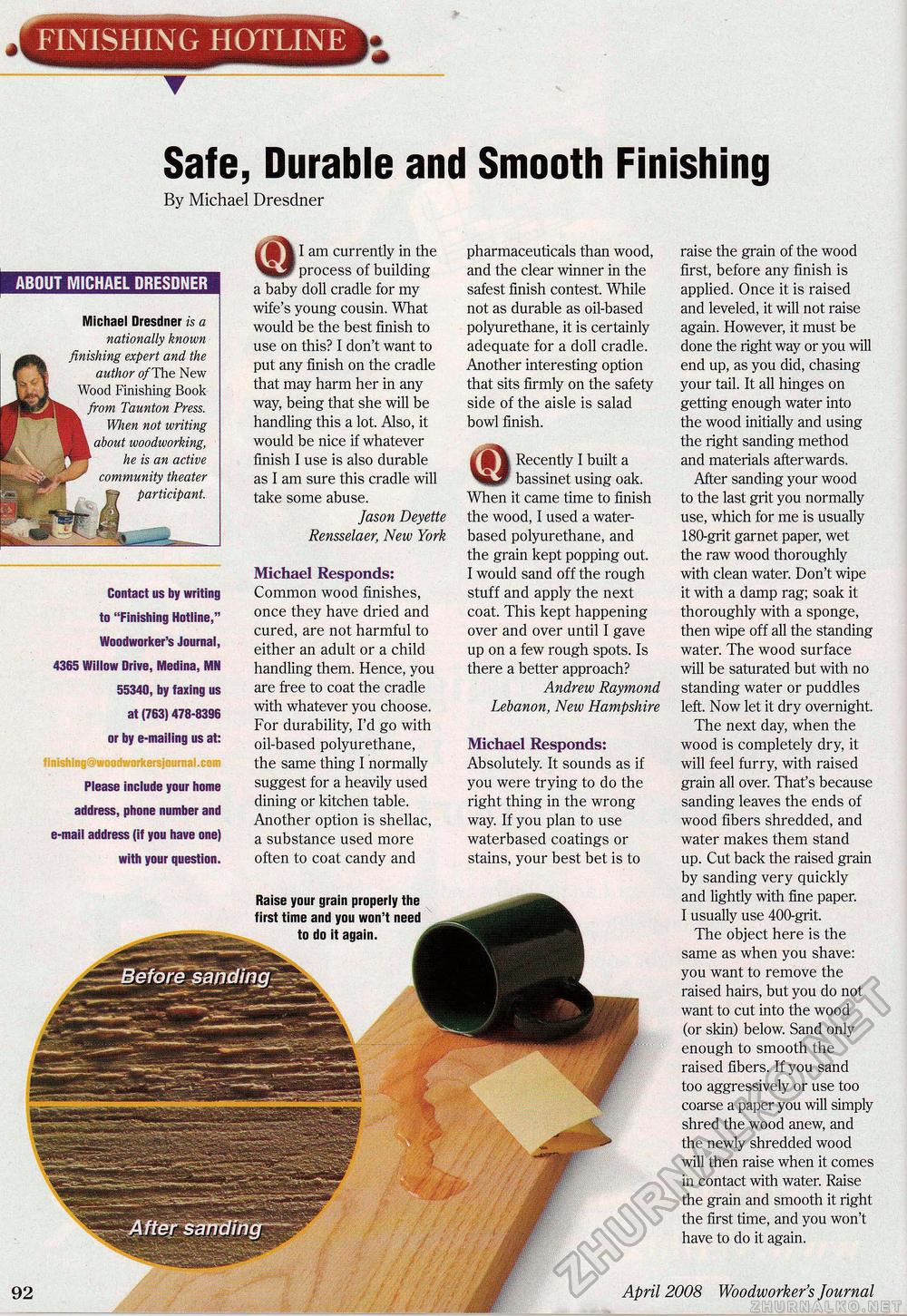Woodworker's Journal 2008-32-2, страница 90
■ FINISHING HOTLINE Ml * Safe, Durable and Smooth Finishing By Michael Dresdner ABOUT MICHAEL DRESDNER I am currently in the process of building a baby doll cradle for my wife's young cousin. What would be the best finish to use on this? I don't want to put any finish on the cradle that may harm her in any way, being that she will be handling this a lot. Also, it would be nice if whatever finish I use is also durable as I am sure this cradle will take some abuse. Jason Deyette Rensselaer, New York Michael Responds: Common wood finishes, once they have dried and cured, are not harmful to either an adult or a child handling them. Hence, you are free to coat the cradle with whatever you choose. For durability, I'd go with oil-based polyurethane, the same thing I normally suggest for a heavily used dining or kitchen table. Another option is shellac, a substance used more often to coat candy and Raise your grain properly the first time and you won't need 90 April 2008 Woodworker's Journal Contact us by writing to "Finishing Hotline," Woodworker's Journal, 4365 Willow Drive, Medina, MN 55340, by faxing us at (763) 478-8396 or by e-mailing us at: iBisMtig<s^08®swtef§j08firai.sam Please include your home address, phone number and e-mail address (if you have one) with your question. pharmaceuticals than wood, and the clear winner in the safest finish contest. While not as durable as oil-based polyurethane, it is certainly adequate for a doll cradle. Another interesting option that sits firmly on the safety side of the aisle is salad bowl finish. Recently I built a bassinet using oak. When it came time to finish the wood, I used a water-based polyurethane, and the grain kept popping out. I would sand off the rough stuff and apply the next coat. This kept happening over and over until I gave up on a few rough spots. Is there a better approach? Andrew Raymond Lebanon, New Hampshire Michael Responds: Absolutely. It sounds as if you were trying to do the right thing in the wrong way. If you plan to use waterbased coatings or stains, your best bet is to <d raise the grain of the wood first, before any finish is applied. Once it is raised and leveled, it will not raise again. However, it must be done the right way or you will end up, as you did, chasing your tail. It all hinges on getting enough water into the wood initially and using the right sanding method and materials afterwards. After sanding your wood to the last grit you normally use, which for me is usually 180-grit garnet paper, wet the raw wood thoroughly with clean water. Don't wipe it with a damp rag; soak it thoroughly with a sponge, then wipe off all the standing water. The wood surface will be saturated but with no standing water or puddles left. Now let it dry overnight. The next day, when the wood is completely dry, it will feel furry, with raised grain all over. That's because sanding leaves the ends of wood fibers shredded, and water makes them stand up. Cut back the raised grain by sanding very quickly and lightly with fine paper. I usually use 400-grit. The object here is the same as when you shave: you want to remove the raised hairs, but you do not want to cut into the wood (or skin) below. Sand only enough to smooth the raised fibers. If you sand too aggressively or use too coarse a paper you will simply shred the wood anew, and the newly shredded wood will then raise when it comes in contact with water. Raise the grain and smooth it right the first time, and you won't have to do it again. Michael Dresdner is a nationally known finishing expert and the author of The New Wood Finishing Book from Taunton Press. When not writing about woodworking, he is an active community theater participant. |








